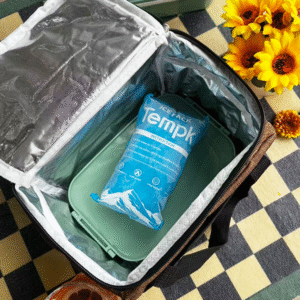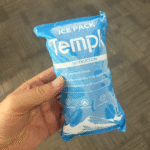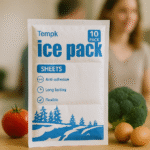O transporte de peixe fresco requer controle preciso de temperatura para garantir qualidade e segurança. As placas de gelo seco são a solução perfeita para manter baixas temperaturas durante o transporte. Neste artigo, discutiremos como usar folhas de gelo seco de maneira eficaz para o transporte de peixes, garantindo a conformidade com os padrões da indústria e maximizando o frescor do seu produto.

-
Os principais benefícios do uso folhas de gelo seco para transporte de peixes.
-
Como selecionar as folhas de gelo seco certas com base no tipo de peixe e na distância de envio.
-
As melhores práticas para embalar e transportar pescado com gelo seco.
-
Desafios comuns no transporte de pescado e como o gelo seco pode ajudar a superá-los.
-
Como cumprir os requisitos regulamentares durante o transporte de gelo seco.
O que são folhas de gelo seco e por que são essenciais para o transporte de peixes?
As placas de gelo seco são projetadas para manter produtos perecíveis, como peixes, na temperatura ideal durante o transporte.. Gelo seco, que sublima a -78,5 ° C, é crucial para manter baixas temperaturas por longos períodos. Essas folhas oferecem desempenho superior no controle de temperaturas e na redução de deterioração em comparação com bolsas de gelo convencionais.
O gelo seco é especialmente benéfico para o transporte de pescado, onde o frescor é crítico. Métodos tradicionais, como bolsas de gel ou gelo normal, não proporcionam resfriamento duradouro, levando a uma deterioração mais rápida. Gelo seco, por outro lado, garante que o peixe permaneça a uma temperatura segura desde o momento em que sai do fornecedor até ao momento em que chega ao destino.
Como funcionam as folhas de gelo seco no transporte de peixes?
Folhas de gelo seco são colocadas ao redor do peixe em um recipiente isolado, garantir que o peixe permaneça congelado ou refrigerado durante o trânsito. O processo de sublimação do gelo seco absorve calor, mantendo baixas temperaturas, impedindo o crescimento bacteriano, e preservando a qualidade do peixe.
A eficiência do gelo seco na manutenção da temperatura depende de vários fatores, incluindo o peso da remessa, duração do envio, e condições ambientais. Calculando a quantidade certa de gelo seco, você pode garantir que sua remessa permaneça dentro da faixa de temperatura exigida durante toda a viagem.
Como escolher as folhas certas de gelo seco para envio de peixes
Selecionar as placas de gelo seco certas é fundamental para garantir que os peixes cheguem em ótimas condições. Aqui estão alguns fatores a serem considerados:
-
Tipo de peixe: Alguns peixes, como atum ou salmão, requerem temperaturas de congelamento mais profundas, enquanto outros, como bacalhau ou arinca, são menos sensíveis. O tipo de peixe determinará a quantidade de gelo seco necessária.
-
Duração da remessa: Remessas mais longas exigem mais gelo seco. É essencial calcular quanto gelo seco irá sublimar ao longo da duração do transporte para evitar que o peixe aqueça.
-
Condições Ambientais: Se a sua remessa estiver viajando em climas mais quentes, você precisará de gelo seco extra para compensar a temperatura externa.
-
Material de embalagem: Use caixas isoladas ou bolsas térmicas para reter o frio pelo maior tempo possível. Certifique-se de que o gelo seco esteja bem colocado para evitar o contato direto com o peixe, o que pode causar queimaduras de congelamento.
Mesa: Quantidade recomendada de gelo seco com base na duração da remessa
| Duração da remessa | Tipo de peixe | Gelo seco recomendado (libras) | Requisitos de embalagem |
|---|---|---|---|
| 24-48 horas | Atum, Salmão | 5-7 libras | Caixa isolada, vedação hermética |
| 48-72 horas | Bacalhau, Haddock | 4-5 libras | Bolsa térmica isolada, espaço aéreo mínimo |
| 72+ horas | Cavalinha, Pollock | 6-8 libras | Recipiente isolado com monitoramento de temperatura |
Melhores práticas de embalagem e envio para peixes usando gelo seco
Para maximizar os benefícios das placas de gelo seco, é essencial seguir as diretrizes adequadas de embalagem e envio.
-
Pré-resfrie a remessa: Pré-resfrie o contêiner de transporte e o peixe antes de embalar. Isso ajudará a manter a temperatura por mais tempo.
-
Camadas adequadas: Coloque o gelo seco no fundo do recipiente, permitindo ventilação adequada e liberação de gás. Certifique-se de que os peixes estejam embalados de forma segura, mas com espaço para o gelo seco sublimar de forma eficaz.
-
Ventilação: O gelo seco produz gás CO₂ à medida que sublima. Certifique-se de que a embalagem permite que o gás escape para evitar o aumento de pressão, o que pode danificar o recipiente ou o peixe.
-
Use recipientes isolados: Caixas isoladas ou bolsas térmicas são essenciais para manter a temperatura durante o transporte. Certifique-se de que o recipiente esteja bem fechado para evitar flutuações de temperatura.
Desafios no transporte de peixes e como o gelo seco pode ajudar
Embora o gelo seco seja altamente eficaz para o transporte de pescado, não vem sem seus desafios. Problemas comuns incluem:
-
Taxa de sublimação: O gelo seco sublima a uma taxa fixa, o que às vezes pode levar a um resfriamento insuficiente se não for calculado corretamente. É por isso que é importante planejar com antecedência e calcular quanto gelo seco será necessário para o envio.
-
Atrasos no envio: Atrasos inesperados podem fazer com que os peixes aqueçam, mesmo com gelo seco. Certifique-se de que seu fornecedor de remessa possa garantir a entrega no prazo para minimizar o risco de deterioração.
-
Conformidade Regulatória: O transporte de peixe com gelo seco exige o cumprimento de vários regulamentos, incluindo rotulagem e manuseio adequados. Certifique-se de que sua remessa esteja claramente etiquetada com “Dióxido de Carbono Sólido” e o peso correto do gelo seco usado.
Como evitar problemas de envio de gelo seco
-
Plano para atrasos: Escolha serviços de remessa confiáveis e use dispositivos de monitoramento de temperatura para monitorar a condição da sua remessa em tempo real.
-
Rotule corretamente: Certifique-se de que seu gelo seco esteja devidamente rotulado com os sinais de alerta apropriados, incluindo “Dióxido de Carbono Sólido” e o peso líquido correto.
-
Monitore as taxas de sublimação: Calcule quanto gelo seco você precisará com base no tempo de trânsito esperado, temperatura, e tipo de peixe.
Requisitos Regulamentares para Transporte de Peixe com Gelo Seco
O transporte de pescado com gelo seco é regulamentado para garantir a segurança dos manipuladores e do meio ambiente. Alguns regulamentos importantes a serem considerados incluem:
-
Regulamentos DOT: Os EUA. O Departamento de Transporte exige que as remessas de gelo seco sejam devidamente etiquetadas e embaladas. O gelo seco deve ser declarado como material perigoso em remessas aéreas.
-
Diretrizes IATA: Para transporte aéreo, A Associação Internacional de Transporte Aéreo (IATA) tem regras rígidas para a quantidade de gelo seco usada nas remessas. Estas diretrizes garantem que haja ventilação adequada e manuseio seguro do gás liberado durante a sublimação.
Perguntas frequentes sobre o envio de peixes com gelo seco
Q1: Posso usar gelo seco para transportar peixes durante a noite?
Sim, o gelo seco é uma excelente escolha para remessas noturnas, pois pode manter temperaturas baixas por longos períodos. Certifique-se de que a quantidade de gelo seco seja suficiente com base na duração e no tipo de peixe.
Q2: Como manusear o gelo seco com segurança ao embalar peixes?
Sempre use luvas ao manusear gelo seco para evitar queimaduras. Certifique-se de que o recipiente esteja bem ventilado para permitir que o gás CO₂ escape com segurança.
Conclusão: Por que as placas de gelo seco são a melhor escolha para o transporte de peixes
Folhas de gelo seco oferecem controle de temperatura incomparável para o transporte de peixes, garantindo que eles permaneçam frescos e seguros durante o transporte. Selecionando a quantidade certa de gelo seco, usando embalagem adequada, e aderindo aos regulamentos, você pode garantir os melhores resultados para suas remessas. Seja proativo no planejamento e no uso de dispositivos de monitoramento de temperatura para evitar atrasos ou manuseio incorreto.
PRÓXIMOS PASSOS:
Para otimizar seu processo de envio de pescado, consulte um especialista em logística da cadeia de frio para escolher as soluções certas de gelo seco adaptadas às suas necessidades. Entre em contato com a Tempk para obter aconselhamento especializado e kits de remessa confiáveis projetados para manter seu peixe fresco durante o transporte.
Sobre Tempk
E tempk, somos especializados em fornecer soluções inovadoras de cadeia de frio para o transporte de mercadorias perecíveis. Nossas placas de gelo seco e bolsas térmicas são projetadas para garantir o transporte seguro e eficiente de frutos do mar, produtos farmacêuticos, e produtos de biotecnologia. Oferecemos soluções personalizáveis para atender às suas necessidades de envio, garantindo o cumprimento de todos os regulamentos.
Entre em contato: Para soluções personalizadas e aconselhamento especializado, entre em contato conosco hoje para saber como podemos melhorar sua logística de cadeia de frio.























